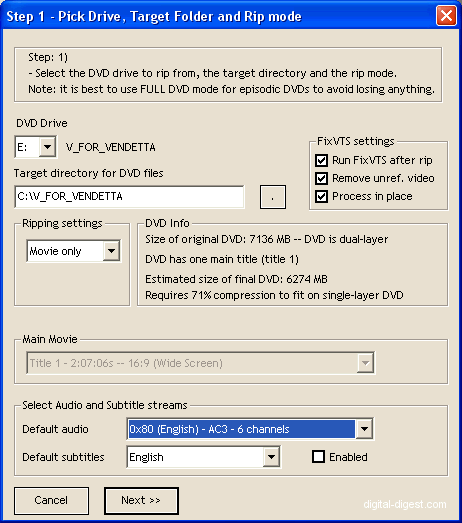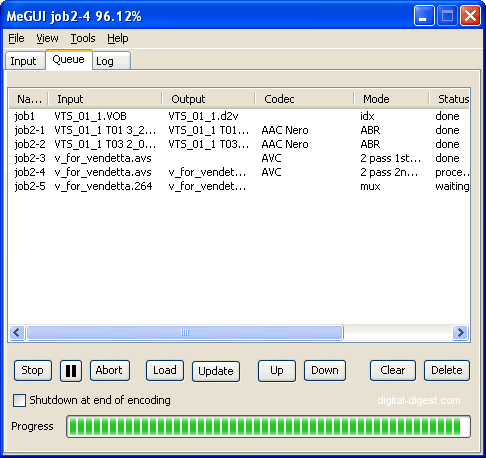MeGUI is one of the newer tools that has been designed with H.264 encoding in mind, while supporting other types of conversion, such as XviD. This guide shows you how to encode a H.264 (MP4) using MeGUI from a DVD as the primary example (instructions for converting other types of video files are also included).
This guide is aimed at intermediate users, basically users that are familiar with DVD conversion/backup and want to experiment with H.264 and MeGUI. As such, basic knowledge of DVD ripping and conversion is required, although brief instructions will be provided in any case.
Software you'll need (all freeware):


 Step 1: Installation
Step 1: Installation
 Step 2: DVD Ripping
Step 2: DVD Ripping
This step will rip (copy) the DVD files from the DVD disc to your hard drive, for further processing or burning straight to a DVD recordable. This step uses RipIt4Me (which will control and use DVD Decrypter, FixVTS as needed). Before you run RipIt4Me, make sure you don't have any other DVD decrypting/ripping tools running (like DVD43, AnyDVD, DVD Region+CSS Free) and also close any
conflicting programs. The instructions here are for you typical movie DVD - for episodic DVDs (eg. TV shows), please refer to
this RipIt4Me FAQ entry.
There are some running tips/notices for RipIt4Me in the
official guide (just below the table of contents).
This guide will not cover all aspects of RipIt4Me operation. If you run into problems or see error messages in this step, or simply want to read a more detailed guide on RipIt4Me, please refer to the
official RipIt4Me guide. There is also a
frequently asked questions document.
Pop the source DVD disc into your DVD drive.
Start RipIt4Me. From the "Logs/Settings" menu, select "Preferences" and uncheck the "Run DVD Shrink after rip" option under the "1-click" mode section. Press the "OK" button to save the changes.
Click on the

button. The following screen should come up:

Check to make sure the selected DVD drive letter is the correct one. The default output directory is based on the DVD's title, and this should be fine. Change the ripping setting to "Movie only" (again, if your DVD is an episodic one, please refer to
this RipIt4Me FAQ entry). The available audio and subtitle streams should now be shown down the bottom - you don't need to change anything, but you need to note down the stream number (eg. 0x80 => 1st stream, 0x81 => 2nd stream) for the audio, which you'll need to know for MeGUI. Press "Next" to continue.
RipIt4Me will now automatically start and operate all the required programs for ripping. When ripping has been finished, you will get a dialog box notifying you that the logs have been moved to another directory. You can view previously saved logs by using the "Log/Settings" -> "View saved logs" function (log files are needed when you run into a problem and want to get help in our (official)
RipIt4Me forum.
The DVD has now been ripped. You can now close RipIt4Me.
 Step 3: D2V Creator
Step 3: D2V Creator
 Step 4: AviSynth Script Creator
Step 4: AviSynth Script Creator
 Step 5a: Video Encoding Options MP4
Step 5a: Video Encoding Options MP4
 Step 5b: Video Encoding Options XVID
Step 5b: Video Encoding Options XVID

After the AviSynth Script Creator window closes, it will be entered in the AviSynth Script box on the Input tab. Below that is the output file. Click the button to the right of it to change the location or name. Select the dropdown menu next to Codec and set it to XviD. File Format should be set to AVI, MKV, or RAWASP (MP4). To select a Video Profile, determine what percentage of original DVD's bitrate will be used for the XviD encode. If you're not sure, compare the combined size of the VOB files to the intended final size of the XviD. The profiles are named by what amount of compression they're designed for. For example, XviD '>90% comp. check' means it's for encodes that are 90% as big as the original or more. Find the largest percentage that's smaller than or equal to the amount of compression your encode will have. Each compression level will have a fast and HQ option. As the names suggest, one will give you faster encodes, and the other a little higher quality.
 Step 6: Audio Encoding Options
Step 6: Audio Encoding Options
Now it's time to set up the audio encoding options. If you've followed this guide for DVD conversion, then the demuxed audio track we selected in the D2V Creator should already be loaded in (if not, load in the .ac3 file that was created). If you are not converting from a DVD source, then you can either load in a separate audio file or if you edited the AviSynth script (set "audio=true"), then load in the AVS file into the "Audio Input" section (meaning both video and audio inputs are the same AVS file). Repeat if you want a second audio track by clicking on the "2" select option.
Now we select an audio codec to use. I prefer AAC audio, especially with H.264 as video - AAC is to MP3 what H.264 is to DivX/XviD, better compression + better quality. So which audio codec should you use? I prefer ND AAC (Nero Digital), so select it if you agree with me. We can now choose an audio profile from one of the "NDAAC" options. "NDAAC-HE-64Kbps" is the one I like, as it will give you roughly the same quality as a 128 Kbps MP3 file. You can select one of the "HEPS" (HEv2) profiles if you really want a small file size. The "LC" options offer better compatibility (eg. with iPod/iTunes), but at the cost of file size (still smaller than MP3s though).
 Step 7: AutoEncode and starting the encoding
Step 7: AutoEncode and starting the encoding
We're nearly finished. Press the "AutoEncode" button to launch the Automatic Encoder setup windows.
This is pretty straight forward - just specify the output size of your video file (and make sure the Container is set correctly, to "MP4" for the purpose of this guide). The output location can be changed as well - this file will be the final output file that you want, so make sure you remember where you put it and don't accidentally delete it when cleaning up (I like to put this file in a different folder to all the other files, just in case). Press the "Queue" button and all the necessary jobs will be added to the encoding queue.
Click on the "Queue" tab and all the jobs should be listed there. An explanation of the queued jobs shown in the screenshot below:
- job1: D2V Creation (already finished)
- job2-1: Encoding audio track 1
- job2-2: Encoding audio track 2
- job2-3: Encoding video, 1st pass
- job2-4: Encoding video, 2nd pass
- job2-5: Muxing audio and video to MP4

When you're ready to start, press the "Start" button to start the encoding and when it's all finished, your MP4 file should be ready. You can delete all the other files, unless you plan on making more encodings from them.
We're done

 MeGUI Custom x264/AVC video profiles. (Updated: 2006-12-21)
Url to this pages:
http://nade.dk/web/nade/site.nsf/FramesetHP?readform&wmain=files/Megui
MeGUI Custom x264/AVC video profiles. (Updated: 2006-12-21)
Url to this pages:
http://nade.dk/web/nade/site.nsf/FramesetHP?readform&wmain=files/Megui